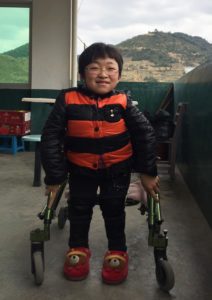Story 17 – Su Yu Xin

Xin Xin lives in a remote village in Fujian with her family. When she turned 100 days old, her parents threw a party for her. During the party, she suddenly started to cry, and her parents could not figure out the reason. The village doctor thought she might be overstimulated. The next day, they brought her to the town hospital, where the doctor said that Xin Xin was experiencing acute infantile convulsion (TCM). After taking medicine for three days and the situation did not improve, her parents brought her to the county hospital. At the county hospital, the doctor had an X-ray conducted. They found that she had broken two breastbones, three ribs and one femur. Retrospectively, her parents realized that these fractures were possibly due to the many hugs she received during the party.
Since then, Xin Xin experienced multiple fractures, and no one knew the cause. After many visits to the hospital, she was ultimately diagnosed with Osteogenesis Imperfecta (OI), also known as “Brittle Bone Disease”, a genetic disorder causing the patient to have fragile bones. Moreover, during every visit to the hospital, her bones would fracture from the bumpy ride due to poor road infrastructure in her living area. Her limbs started to deform at her age of four because of multiple fractures.
Xin Xin was not able to walk and could not take care of herself. Due to financial reasons, her parents could not quit their jobs in order to take care of her, so she was forced to drop out of school at the age of 11. By the age of 13, Xin Xin had suffered from over 50 fractures, putting huge financial and emotional pressure on her family. Because of the disease, her growth was also hindered. She was merely a meter tall at the age of 13.
From the age of five to 12, Xin Xin had nine surgeries in China to correct her limb deformities. Unfortunately, nine months after these surgeries, she started coughing and being short of breath with pain in her lower back. After assessment at a hospital, she was found to have an abnormal forward curvature at the lower end of her spine, which obstructed her lungs and affected her cardiopulmonary function. This made her suffer from asthma, and her parents were informed that she would get pneumonia if left untreated, which might threaten her life.
 Professor Kenneth Cheung and Dr. Michael To suggested surgical treatment to correct Xin Xin’s abnormally curved spine and thus stabilize her spinal deformity, treating her asthma in the process. The cost of this surgery was immensely high, and her family could not afford it. However, with sponsorship from SRDC, Xin Xin’s one-stage ultra-major surgery at the Queen Mary Hospital was conducted in 2016. She underwent long spinal fusion and stayed for another two days for post-operative care. Xin Xin then had a two-week clinical observation before she was discharged and returned to her home in Fujian. There, she wore a spinal brace for six weeks to protect her spine, and now she is able to sit up for long periods of time and does not easily get tired. Her asthma issue is also mostly relieved. The only issue she experiences is very minor and occasional backache.
Professor Kenneth Cheung and Dr. Michael To suggested surgical treatment to correct Xin Xin’s abnormally curved spine and thus stabilize her spinal deformity, treating her asthma in the process. The cost of this surgery was immensely high, and her family could not afford it. However, with sponsorship from SRDC, Xin Xin’s one-stage ultra-major surgery at the Queen Mary Hospital was conducted in 2016. She underwent long spinal fusion and stayed for another two days for post-operative care. Xin Xin then had a two-week clinical observation before she was discharged and returned to her home in Fujian. There, she wore a spinal brace for six weeks to protect her spine, and now she is able to sit up for long periods of time and does not easily get tired. Her asthma issue is also mostly relieved. The only issue she experiences is very minor and occasional backache.
Xin Xin is now a piano teacher, spending her time teaching children how to play the piano at home, and she and her family are extremely grateful towards all of the doctors involved and SRDC.
